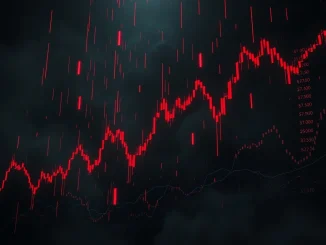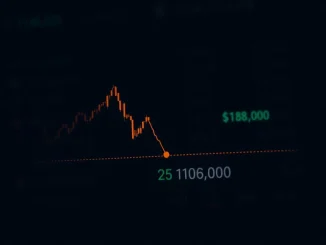
The cryptocurrency market just saw a significant event unfold. In a dramatic display of volatility, approximately $115 million worth of crypto futures contracts were liquidated in the past hour alone. This sharp move follows a larger trend, with the past 24 hours seeing a staggering $588 million in total liquidations across major exchanges. For anyone involved in crypto, especially those using leverage, understanding what this means is crucial.
What Exactly is Crypto Futures Liquidation?
Before diving into the numbers, let’s quickly clarify what crypto futures liquidation involves. A futures contract is an agreement to buy or sell a cryptocurrency at a specific price on a future date. Traders often use leverage with these contracts, borrowing funds to open larger positions than their initial capital would allow. While leverage can amplify profits, it also significantly increases risk.
Liquidation occurs when a trader’s leveraged position is automatically closed by the exchange. This happens because the market price has moved against their trade to such an extent that they no longer meet the margin requirements (the minimum equity needed to keep the position open). Essentially, they run out of collateral to cover potential losses, and the exchange closes the position to prevent further debt.
The Scale of Recent Futures Liquidation
The figures we’ve seen are substantial:
- $115 million liquidated in the past hour: This indicates a very rapid and sharp price movement occurred recently, catching many leveraged traders off guard.
- $588 million liquidated in the past 24 hours: This broader figure shows sustained volatility or a series of impactful price swings over the last day.
Major exchanges like Binance, Bybit, OKX, and others are typically where these large liquidation events happen, given their high trading volumes and leverage options. While specific assets aren’t detailed in the initial report, such large-scale liquidations usually involve the largest cryptocurrencies, primarily Bitcoin and Ethereum.
Why Does This Much Futures Liquidation Happen?
Large-scale futures liquidation is almost always a direct result of significant price volatility in the underlying assets. When the crypto market experiences a sudden pump or dump, traders with leveraged long (betting on price increase) or short (betting on price decrease) positions that are on the wrong side of the move can quickly hit their liquidation price levels.
Consider a trader with a highly leveraged long position. If the Bitcoin price suddenly drops sharply, their margin could quickly fall below the required level, triggering an automatic liquidation. Similarly, a sudden price surge liquidates leveraged short positions.
This can sometimes create a cascade effect: as positions are liquidated, the forced selling (or buying) can add further pressure to the market price, triggering *more* liquidations, and so on. This contributes to rapid price swings.
Understanding the Risks of Leveraged Trading
The recent liquidation numbers serve as a stark reminder of the inherent risks associated with leveraged trading in the volatile crypto market. While leverage can be tempting for its potential to magnify gains, it equally magnifies losses. A small price movement against your position can lead to the total loss of your collateral, and potentially more depending on the contract type and exchange rules.
For traders, understanding their liquidation price and using risk management tools like stop-loss orders is crucial. High leverage amplifies both profit potential and the speed at which liquidation can occur.
What Does This Mean for the Crypto Market?
Significant liquidation events often signal periods of increased volatility. They can sometimes ‘cleanse’ the market of overly leveraged positions, potentially paving the way for more stable price action, or they could precede further large moves if the underlying catalyst persists.
Monitoring liquidation data provides insight into market sentiment and potential areas of price sensitivity. Large clusters of liquidation levels can sometimes act as magnets for price movements.
Actionable Insights for Traders
- Assess Your Leverage: Are you using appropriate leverage for your risk tolerance and market conditions?
- Know Your Liquidation Price: Always understand at what price your position will be liquidated.
- Use Stop-Loss Orders: Implement stop-losses to automatically close a position before it reaches liquidation, preserving some capital.
- Understand Market Volatility: The crypto market is known for sudden swings. Trade accordingly.
- Don’t Overcommit: Only trade with capital you can afford to lose.
Conclusion: Volatility Remains a Constant
The recent event, seeing $115 million worth of crypto futures liquidated in the past hour amidst a larger $588 million sweep in 24 hours, underscores a fundamental truth about the crypto market: volatility is a constant companion. While it presents opportunities, especially with tools like leveraged trading, it also carries significant risks, as highlighted by these massive liquidation figures. Traders must prioritize robust risk management strategies to navigate these turbulent waters and protect their capital.



